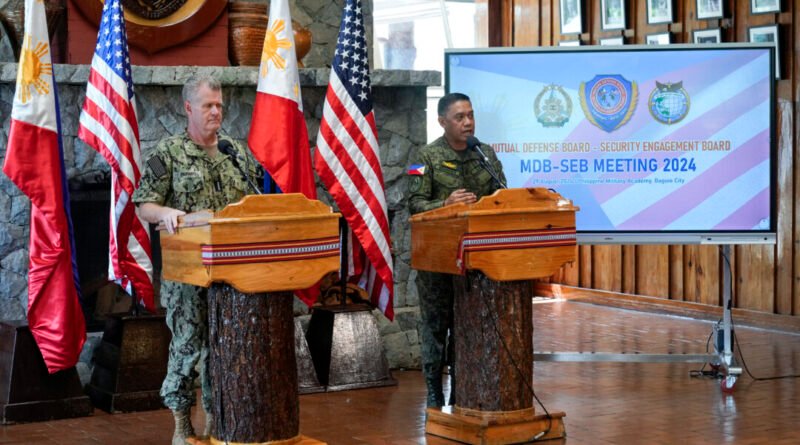US Admiral Says US Forces Prepared to Deal with South China Sea Aggression Using Various Options
BAGUIO, Philippines—American forces are prepared with multiple options to address escalating acts of aggression in the disputed South China Sea if instructed to do so in collaboration with treaty ally the Philippines, according to a U.S. admiral on Thursday.
Adm. Samuel Paparo, chief of U.S. Indo-Pacific Command, which commands the largest number of combat forces outside the U.S. mainland, declined to provide specifics on the contingency plans during a news conference.
Paparo’s remarks were in response to a question about how the longstanding treaty allies could respond to Beijing’s “gray-zone tactics” in the contested waters.
“Gray-zone tactics” refer to actions such as water cannon fire and the obstruction and ramming of rival ships in disputed waters that fall below the threshold of an actual armed attack, preventing the Philippines from invoking its 1951 Mutual Defense Treaty with the United States, which mandates mutual assistance in the event of an external armed attack.
“We have indeed developed a range of options and USINDOPACOM is prepared, if necessary and after consultations as per the treaty, to implement those options in conjunction with our ally,” Paparo stated.
According to Paparo, disclosing these U.S. military options could enable the potential adversary to counter them.
Paparo and Gen. Romero Brawner Jr., Chief of the Armed Forces of the Philippines, held a joint news conference after overseeing an annual meeting in Baguio to discuss security concerns and military strategies, including Balikatan—meaning “shoulder to shoulder”—the largest military exercises involving over 16,000 American and Filipino troops, partially conducted in the South China Sea this April.
In response to a query, Paparo reiterated the U.S. military’s willingness to escort Philippine vessels in the South China Sea following consultations, despite the heightened tensions between Beijing and Manila in the disputed waters. Such actions could potentially lead to direct confrontations between U.S. and Chinese naval vessels.
Tensions between Washington and Beijing have escalated due to the Chinese regime’s aggressive actions to protect its territorial claims in the South China Sea and its ambition to forcibly annex Taiwan.
Brawner reassured that the Philippines has the ability to defend itself in the contested waters, where confrontations with various Chinese maritime forces have intensified significantly in recent times.
“If we exhaust all options without success, then we may seek assistance,” Brawner informed reporters, emphasizing that “we still have numerous alternatives.”
During the joint exercises in April, the U.S. military deployed a mid-range missile system to the northern Philippines, sparking outrage from Beijing, which warned of regional arms race risks and stability concerns. China demanded the removal of the missile system, capable of threatening mainland China, from the Philippines.
Paparo and Brawner declined to disclose whether or when the missile system would be withdrawn from the Philippines. Brawner expressed gratitude to the U.S. military for introducing advanced defense equipment to Filipino forces, stating that it would facilitate training for future acquisitions by the Philippine military.
“Similar to our previous experiences with Stingers and Javelins, we are already engaging in training even before their actual acquisition,” Brawner remarked.
The Chinese regime has drawn criticism from the Philippines for recurrently harassing its navy and coast guard ships with aggressive tactics including water cannons, lasers, blockades, and risky maneuvers near disputed South China Sea shoals. These actions have resulted in minor clashes causing injuries to Filipino naval personnel and damage to supply vessels.
Beijing has accused the Philippines of instigating these hostilities in the disputed waters by encroaching on what it deems as its maritime territories, delineated by ten dashes on a map. China asserts that its naval forces have been compelled to expel Philippine vessels from these areas.
The Philippines has consistently referenced a 2016 international arbitration ruling based on the UN Convention on the Law of the Sea, which invalidated China’s expansive claims in the South China Sea based on historical grounds.






